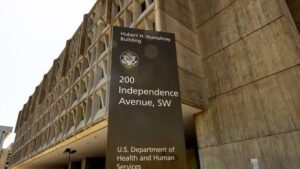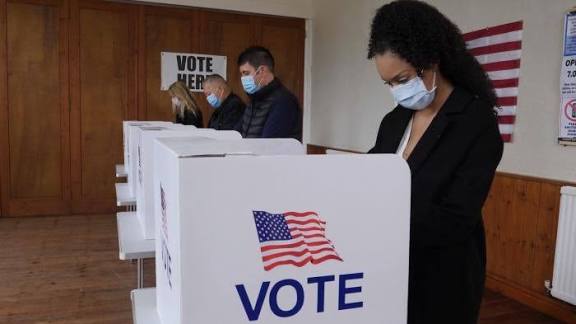HHS Fires 10,000 Workers: Experts Warn US Health Services Could Collapse

The U.S. Department of Health and Human Services announced Thursday it is cutting 10,000 full-time staff across health agencies. Today we will discuss about HHS Fires 10,000 Workers: Experts Warn US Health Services Could Collapse
HHS Fires 10,000 Workers: Experts Warn US Health Services Could Collapse
In an unprecedented shake-up, the U.S. Department of Health and Human Services (HHS) is slashing around 10,000 full-time positions in a sweeping reorganization led by Health Secretary Robert F. Kennedy Jr. The cuts, which amount to nearly a quarter of the department’s workforce, have sparked acute concern among public health experts, union leaders, and disability advocates about the future capacity of America’s health infrastructure.
Critics warn that eliminating these roles — particularly in key agencies like the FDA, CDC, and NIH — risks undermining disease surveillance, food safety, and biomedical research. The result, they argue, could be a footrace for public health systems to catch up when the next crisis hits.
Background: What’s Driving the Cuts?

A Bold Restructuring Plan
At the heart of this dramatic downsizing is a reorganization effort championed by Kennedy, who has called HHS a “sprawling bureaucracy” burdened by redundancy and inefficiency. Under the new plan, HHS divisions will shrink from 28 to 15, while regional offices will be cut from 10 to 5. One of the most significant changes: the creation of a new agency, the Administration for a Healthy America (AHA), which will combine functions related to addiction, environmental health, mental health, and workforce under a central umbrella.
Scale of Workforce Reduction
The reorganization includes:
10,000 job cuts via layoffs.
An additional ~10,000 employees who have already accepted early retirement or voluntary separation offers.
Overall, HHS aims to shrink from approximately 82,000 to 62,000 full-time employees.
Some of the biggest reductions are planned in specific sub-agencies: 3,500 jobs at the FDA, 2,400 at the CDC, 1,200 at NIH, and 300 at CMS (Centers for Medicare & Medicaid Services).
Why the Cuts Are Raising Alarms
While HHS presents this overhaul as a mission-driven effort to refocus the department on its core priorities, many in the public health community see real and alarming risks.
Erosion of Public Health Capacity
The CDC, which plays a central role in disease surveillance and outbreak response, is set to lose 2,400 employees under the restructuring. Experts warn that such a reduction could cripple the U.S.’s ability to respond to epidemics, monitor emerging threats, or even handle routine public health functions.
Workers at CDC and other public health bodies have expressed “devastation,” describing the cuts as more than a bureaucratic pruning — as something that could fundamentally erode capacity.
Weakening Food Safety Mechanisms
Among the most contentious impacts: the Food and Drug Administration (FDA) is suspending its Food Emergency Response Network (FERN) proficiency testing program. This network is critical for ensuring food-testing labs across the U.S. maintain quality and accuracy when identifying pathogens and contaminants. Without it, the risk of undetected foodborne illness could rise.
One internal FDA email flagged that key scientific and quality control staff have been let go, including microbiologists and chemists — experts who had been overseeing food safety checks. The cutoff affects not just routine food safety but also the agency’s capacity to detect emergent threats like bird flu in food products.
Threats to Vulnerable Populations
Perhaps the most worrying voices come from disability advocates and public health workers who warn that these reductions disproportionately endanger vulnerable populations — including people with disabilities, the elderly, and communities in need.
Agencies serving people with disabilities have been gutted. The Administration for Community Living (ACL), a critical hub for aging and disability services, has lost nearly half its staff, including regional leadership, grant-making personnel, and outreach officers. Without these roles, essential services like community care, disability research, policy guidance, and data gathering may worsen.
Political and Ideological Drivers
A Push for “Doing More with Less”
Robert F. Kennedy Jr. and his allies frame the restructuring as a moral and fiscal necessity. He argues that despite HHS’s huge annual budget, outcomes — particularly in reducing chronic disease — remain disappointing. The aim, he says, is to cut waste, eliminate duplication, and reorient the department around core public health goals.
The new centralized AHA is also designed to streamline functions like communications, human resources, IT, procurement, and external affairs — consolidating what HHS calls fragmented and inefficient operations.
The Role of Ideology
Part of this realignment stems from a broader government-wide initiative to shrink federal bureaucracy. Some see this as not just about cost-cutting, but an aggressive downsizing of government’s role in public health.
Bipartisan Friction
Lawmakers have responded with alarm. Democratic senators warned that slashing staff in the middle of infectious disease outbreaks could imperil lives. Meanwhile, a House committee report estimated that the cuts could eliminate billions in economic activity and cost tens of thousands of jobs beyond HHS itself.
Expert Reactions and Warnings
Public Health Specialists
Public health experts point to a clear risk: reduced capacity to detect and respond to disease outbreaks. Dismantling disease surveillance networks could prevent health authorities from identifying abnormal illness patterns or spotting a virus in its early stages. If detection lags, containment becomes exponentially harder.
In addition, the suspension of quality‑control programs for food labs raises the specter of compromised food safety standards — which could lead to more frequent or severe food-borne illnesses.
Researchers and Scientists
At the NIH, where 1,200 jobs are slated for cuts, there is concern over the long-term impact on research capacity. Scientists fear that administrative reductions may undermine not just budgeting and planning, but also cross-institutional collaboration that fuels major biomedical breakthroughs.
A former NIH official said that “the only way to cut that high of a percentage … is to drastically scale back what NIH does across the board.”
Disability Advocates
Advocacy groups are particularly alarmed. They argue the cuts will destabilize aid to people with mental illness, older adults, and the disabled. They warn of a “calculated dismissal” of public servants who support marginalized groups.
Labor Unions and Workers
Union representatives were notified that 8,000–10,000 workers would be terminated, primarily in administrative areas like HR, IT, and procurement. The moves have provoked strong backlash from employees, many of whom feel blindsided and undervalued.
Some workers report chaotic conditions during the layoff process. According to union leaders, HHS did not provide clear explanations for who was being cut or why. Others allege poor record-keeping, suggesting that erroneous data was used to identify employees for termination.
Real-World Consequences: How Health Services Could Collapse
Weakening of Disease Surveillance and Preparedness
One of the most serious risks is the deterioration of the U.S. public health early-warning system. If the CDC loses critical capacity, surveillance for pandemics, food-borne illness, or environmental health hazards could lapse. Without robust detection, future outbreaks may go unnoticed until they become widespread — putting the country on the back foot.
Delayed Medical Innovation and Drug Approvals
Cutting staff at the FDA and NIH could extend timelines for new drug or device approvals. While HHS claims the cuts will not affect drug reviewers or inspectors, the loss of policy, administrative, and support staff might slow down the regulatory process. This could hamper both innovation and patients’ access to new treatments.
Food Safety Risks
Suspending the FDA’s proficiency testing program in food labs affects more than just internal processes — it jeopardizes the integrity of national food safety. Without standardized and rigorous testing, there is a greater risk of contamination, foodborne illness, or delayed response to emerging threats like bird flu.
Disproportionate Impact on Vulnerable Communities
The cuts to disability-focused agencies underscore a grim reality: marginalized populations may lose vital support. With fewer staff left to manage grants, provide outreach, and coordinate care, services could become fragmented or inaccessible — disproportionately harming people with disabilities, the elderly, and low-income communities.
Erosion of Institutional Knowledge
Many of those being cut are long-time federal workers with deep expertise. Their exit risks not just a numerical reduction, but a meaningful erosion of knowledge — the kind that underpins research, programmatic continuity, and nuanced policy-making.
Defense from HHS: Why They Say This Is Necessary
Efficiency and Accountability
HHS leadership argues that the reorganization is necessary to eliminate redundancies, centralize operations, and refocus on public health priorities. Kennedy has claimed that previous layers of bureaucracy were stifling innovation and leading to waste. By merging disparate units and consolidating core functions, his goal is to make HHS leaner, more agile, and more effective.
Fiscal Savings
The cuts are expected to generate about $1.8 billion in annual savings. In an era of rising federal debt and political pressure to curb big-government spending, this is being framed as a responsible move.
Reallocation of Resources
Rather than simply cutting, HHS asserts that the reorganization will reallocate resources toward front-line health care, scientific research, and disease prevention. The creation of the Administration for a Healthy America is part of that vision — a body that will better coordinate chronic disease prevention, primary care, mental health, and environmental health.
Role Clarification
By consolidating, HHS believes that some agencies — historically operating in silos — can better coordinate and communicate, reducing overlap and increasing clarity about mission and responsibility.
Risks and Mitigations
Risk: Critical gaps in disease response
Mitigation: Strengthen partnerships with state and local health departments and provide transitional support.Risk: Delays in drug approvals
Mitigation: Prioritize retention of core scientific and regulatory reviewers and strategically outsource administrative roles.Risk: Food safety breakdown
Mitigation: Reinstate scaled-down quality-control labs or partner with universities to maintain testing.Risk: Underserving vulnerable populations
Mitigation: Protect staff in disability-focused agencies and monitor service delivery during the transition.Risk: Loss of expertise
Mitigation: Document institutional knowledge and retain experienced employees in transitional mentoring roles.
Political Fallout and Future Trajectory
Lawmakers have raised objections from both sides of the aisle. Some worry the cuts could weaken U.S. readiness for future pandemics, while others argue public health is being sacrificed for ideological cost-cutting. Legal challenges from disability advocacy groups and class-action lawsuits alleging flawed termination data are also emerging.
Whether HHS will reverse some cuts or proceed fully remains to be seen, but the debate highlights the tension between efficiency and resilience in federal health infrastructure.
Conclusion
The decision by HHS to fire 10,000 workers, coupled with voluntary departures, marks one of the most aggressive restructurings in its history. Framed by Secretary Robert F. Kennedy Jr. as a bold effort to eliminate waste and realign the department’s mission, the cuts risk serious unintended consequences.
Public health experts warn that slashing capacity in the CDC, FDA, NIH, and other core agencies could erode America’s ability to monitor disease outbreaks, ensure food safety, and support vulnerable populations. Disability advocacy groups argue that the move disproportionately harms aging and disabled Americans who rely on federal programs. At a time when global health threats persist and the U.S. grapples with chronic disease, the downsizing poses long-term risks.
To stave off a potential collapse of essential health services, HHS must tread carefully. Efficiency cannot come at the cost of resilience. If the reorganization is to succeed, it must include protection for critical functions, transparency, and a commitment to protecting those who rely most on the safety net. Otherwise, the savings achieved could be fleeting — but the damage to public health may last for years.
How useful was this post?
Click on a star to rate it!
Average rating 0 / 5. Vote count: 0
No votes so far! Be the first to rate this post.
About the Author
usa5911.com
Administrator
Hi, I’m Gurdeep Singh, a professional content writer from India with over 3 years of experience in the field. I specialize in covering U.S. politics, delivering timely and engaging content tailored specifically for an American audience. Along with my dedicated team, we track and report on all the latest political trends, news, and in-depth analysis shaping the United States today. Our goal is to provide clear, factual, and compelling content that keeps readers informed and engaged with the ever-changing political landscape.




